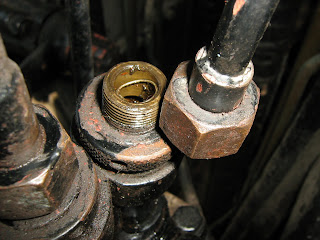 |
| Wire lodged in the pump barrel... |
 |
| ...and extending down into the pump nozzle |
As the individual pumps are constructed at the moment, with brass barrels, the wires do not do anything at all and can be discarded. However, the pumps may have originally been constructed with glass barrels but with the glass later replaced by brass. Glass may even have been an option that was not chosen.
 |
| Brass barrels |
The wire was to catch the droplet as it enters the barrel and guide it upwards along the wire. Without the wire, the droplet could follow any path and tend to deposit itself on the side of the glass so that neither could it be seen nor would it arrive at the top as a droplet. Hence water could be pumped instead of oil and flow monitoring rendered impossible.
With the lubricator mounted under the loco's engine covers, it could not be seen by the loco driver and certainly not able to be adjusted from the cab. Thus, while the loco was being driven, the ability to be able to monitor the oil droplets was of lesser importance.
Sentinel 7109's mechaniacl lubricator will be operated without water in its pump barrels and with opaque (brass) barrel material. Thus, it will operate blind but be able to be adjusted should more or less oil seem necessary.
The flow rate adjustment is made by shortening or lengthening the crank arm of the lubricator so that, for every driving stroke, the pump's camshaft is rotated less or more respectively.
 |
| Lubricator's crank arm length adjustment |
hi
ReplyDeletethe pumps should have glass barrels to view what is being delivered, the glass barrels should also be filled with saline solution to stop the water freezing and breaking the glass. usually if they are taken apart for any reason they are reassembled with plain water and are broken during the next frost and subsequently replace with a brass substitute to avoid further breakage.
greg
Thanks Greg
DeleteI take your point. However, with the lubricator fitted under the engine covers, nobody can see it when in operation. So being able to see through a glass section is of limited use! I'll stick with the brass substitutes for now unless I need visibility during early loco testing. Andy
Actually, rather than water or a saline solution, it works better if you use glycerol, which is immiscible with oil, does not freeze and has a nigh density to allow the oil to rise to the top. You also avoid that nasty emulsion effect sometimes seen when water is used. Glycerol is inexpensive and can be bought from chemists and from Amazon - 1L for about £7.
Delete